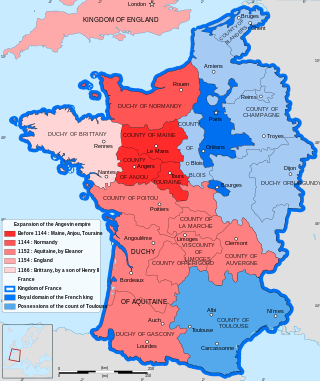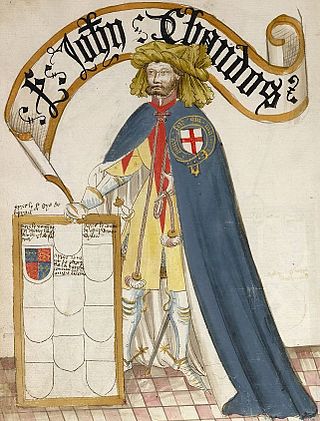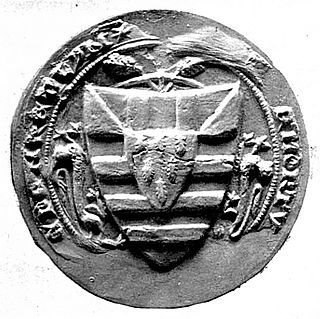This article needs additional citations for verification .(March 2014) |
Edward the Black Prince has been depicted in art, film, literature, plays and games.
This article needs additional citations for verification .(March 2014) |
Edward the Black Prince has been depicted in art, film, literature, plays and games.
Edward the Black Prince features prominently as a character in Edward III , a sixteenth-century play possibly partly attributable to William Shakespeare.
Edward is referred to in Shakespeare's Richard II and Henry V .

Roger Boyle, 1st Earl of Orrery devoted his 1667 play The Black Prince to Edward.
The 1750 play Edward the Black Prince by William Shirley was performed at Drury Lane.


Ivanhoe: A Romance by Walter Scott is a historical novel published in three volumes, in 1819, as one of the Waverley novels. Set in England in the Middle Ages, it marked a shift away from Scott's prior practice of setting stories in Scotland and in the more recent past. It became one of Scott's best-known and most influential novels.

Edward of Woodstock, known to history as the Black Prince, was the eldest son and heir apparent of King Edward III of England. He died before his father and so his son, Richard II, succeeded to the throne instead. Edward nevertheless earned distinction as one of the most successful English commanders during the Hundred Years' War, being regarded by his English contemporaries as a model of chivalry and one of the greatest knights of his age.

Philip VI, called the Fortunate or the Catholic and of Valois, was the first king of France from the House of Valois, reigning from 1328 until his death in 1350.

Edward is an English male given name. It is derived from the Anglo-Saxon name Ēadweard, composed of the elements ēad "wealth, fortune; prosperous" and weard "guardian, protector”.

The Duke of Aquitaine was the ruler of the medieval region of Aquitaine under the supremacy of Frankish, English, and later French kings.
The black knight is a literary stock character who masks his identity and that of his liege by not displaying heraldry. Black knights are usually portrayed as villainous figures who use this anonymity for misdeeds. They are often contrasted with the knight-errant. The character appeared in Arthurian literature and has been adapted and adopted by various authors, in cinema and popular culture. The character is sometimes associated with death or darkness.

The Raigne of King Edward the Third, commonly shortened to Edward III, is an Elizabethan play printed anonymously in 1596, and at least partly written by William Shakespeare. It began to be included in publications of the complete works of Shakespeare only in the late 1990s. Scholars who have supported this attribution include Jonathan Bate, Edward Capell, Eliot Slater, Eric Sams, Giorgio Melchiori, and Brian Vickers. The play's co-author remains the subject of debate: suggestions have included Thomas Kyd, Christopher Marlowe, Michael Drayton, Thomas Nashe, and George Peele.

Long John Silver is a fictional character and the main antagonist in the novel Treasure Island (1883) by Robert Louis Stevenson. The most colourful and complex character in the book, he continues to appear in popular culture. His missing leg and parrot, in particular, have greatly contributed to the image of the pirate in popular culture.

Roger Mortimer, 3rd Baron Mortimer of Wigmore, 1st Earl of March, was an English nobleman and powerful Marcher Lord who gained many estates in the Welsh Marches and Ireland following his advantageous marriage to the wealthy heiress Joan de Geneville, 2nd Baroness Geneville. Her mother was of the Royal House of Lusignan.

Sir John Chandos, Viscount of Saint-Sauveur in the Cotentin, Constable of Aquitaine, Seneschal of Poitou, was a medieval English knight who hailed from Radbourne Hall, Derbyshire. Chandos was a close friend of Edward the Black Prince and a founding member and 19th Knight of the Order of the Garter in 1348. Chandos was a gentleman by birth, but unlike most commanders of the day he held no inherited title of nobility.

The White Company is a historical adventure by British writer Arthur Conan Doyle, set during the Hundred Years' War. The story is set in England, France and Spain, in the years 1366 and 1367, against the background of the campaign of Edward the Black Prince, to restore Peter of Castile to the throne of the Kingdom of Castile. The climax of the book occurs before the Battle of Nájera. Doyle became inspired to write the novel after attending a lecture on the Middle Ages in 1889. After extensive research, The White Company was published in serialised form in 1891 in The Cornhill Magazine. Additionally, the book is considered a companion to Doyle's 1905–06 Sir Nigel, which explores the early campaigns of Sir Nigel Loring and Samkin Aylward.
Ronald Welch was the pseudonym of Welsh writer Ronald Oliver Felton TD, who wrote in English. He is best known for children's historical fiction. He won the 1956 Carnegie Medal from the Library Association for the year's best children's book by a British author, for Knight Crusader, the first in his so-called Carey Family series of novels.
Richard I of England has been depicted many times in romantic fiction and popular culture.

John of England has been portrayed many times in fiction, generally reflecting the overwhelmingly negative view of his reputation.
Edward I of England has been portrayed in popular culture a number of times.
Edward III of England has been depicted in a number of fictional works.

The town of Limoges had been under English control but in August 1370 it surrendered to the French, opening its gates to the Duke of Berry. The siege of Limoges was laid by the English army led by Edward the Black Prince in the second week in September. On 19 September, the town was taken by storm, followed by much destruction and the deaths of numerous civilians. The sack effectively ended the Limoges enamel industry, which had been famous across Europe, for around a century.

Roger Mortimer, 1st Baron Mortimer of Chirk was a 14th-century Marcher lord, notable for his opposition to Edward II of England during the Despenser War.

Edward of Angoulême was second in line to the throne of the Kingdom of England before his death. Born in Angoulême, he was the eldest child of Edward, Prince of Wales, commonly called "the Black Prince", and Joan, Countess of Kent, and thus was a member of the House of Plantagenet. Edward's birth, during the Hundred Years' War, was celebrated luxuriously by his father and by other monarchs, such as Charles V of France.
{{cite magazine}}: Cite magazine requires |magazine= (help)